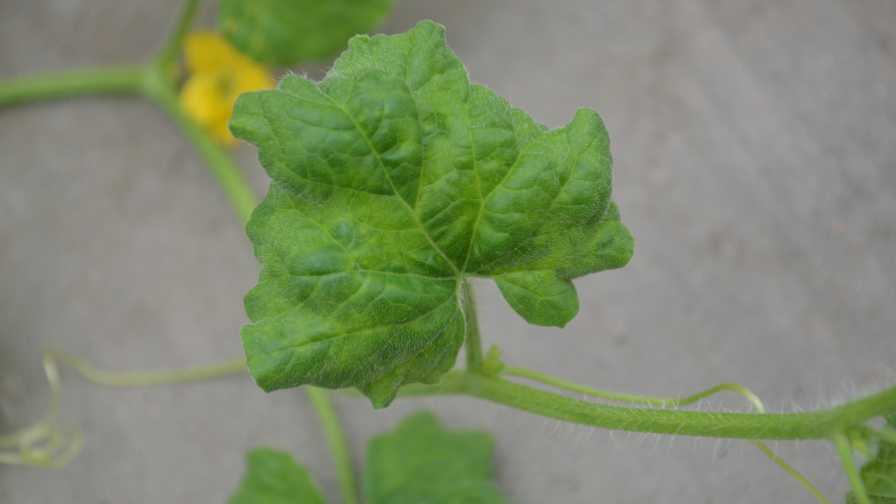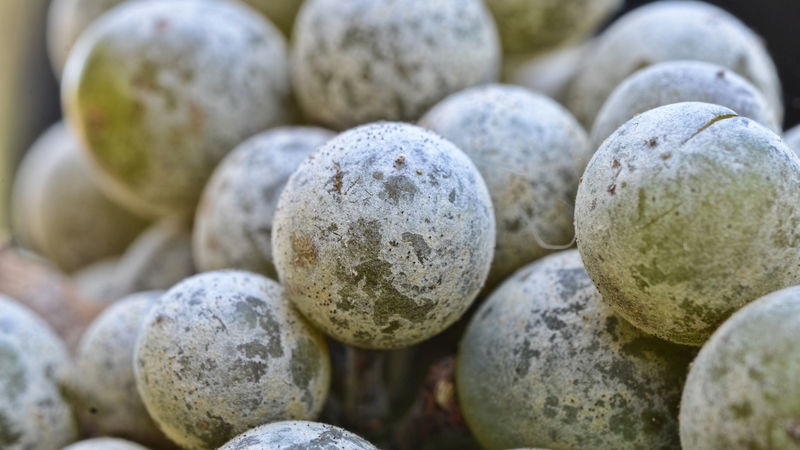Field Scouting Guide: Cucumber Mosaic Virus

Symptoms of cucumber mosaic virus include down curling, followed by leaf crumple, and light green to yellow mosaic.
Photo courtesy of Robert Gilbertson, University of California, Davis
This edition of American Vegetable Grower magazine’s “Field Scouting Guide” concentrates on Cucumber mosaic virus (CMV). Our contributor is Robert Gilbertson, University of California, Davis.
All comments in this article are from Gilbertson.
BASICS
Scientific name: Cucumber mosaic virus (CMV)
Common name: Cucumber mosaic virus
Geographical Range: Worldwide in temperate, subtropical, and tropical regions.
Crops affected: CMV has a very wide host range and has been reported to infect more than 1,200 plant species including banana, common bean, cucurbits (cucumber, melon, pumpkin, and squash, but rarely watermelon), lettuce, pepper, spinach, tomato, and various ornamental species. The mode of transmission is any aphid species in a non-persistent manner.
PEST IMPACT
CMV is becoming increasingly important for production of cucurbits in the Central and Imperial Valleys of California, as well as the Yuma, AZ, vegetable production area where it can cause economic losses. It also causes losses in many crops worldwide. In the case of cucurbits, the primary impact is reduction of yield and fruit quality.
CMV causes more damage when infection occurs early in crop development, especially when plants are infected prior to flowering. Later infection can result in development of symptoms on fruit and can reduce the yield and quality.
IDENTIFICATION
Cucurbit plants infected early in development typically show strong epinasty and down curling, followed by leaf crumple and light green to yellow mosaic. Plants infected later may have reduced fruit set or produce fruit that are smaller than normal — distorted or deformed — and sometimes discolored. Fruit can be mottled and bumpy (particularly common in cucumber). Seed production and quality can be reduced as well.
There are many other factors that can cause similar symptoms to those caused by CMV infection, such as:
- Symptoms caused by infection with other viruses, particularly those caused by squash mosaic virus or by the ‘potyvirus complex,’ which include watermelon mosaic virus (WMV), zucchini yellow mosaic virus (ZYMV), and papaya ringspot virus.
- Abiotic conditions such as nutrition deficiency.
- Herbicide drift or contamination in soil can lead to foliar distortion and symptoms that can resemble symptoms caused by CMV, particularly early in development.
- Genetic chimeras can produce mosaic patterns on leaves that can resemble CMV symptoms.
RECOMMENDED TREATMENT
The most effective treatment is:
Traditional chemistries
As part of an overall IPM program, properly timed insecticide applications can be used to manage aphid vector populations to slow the spread of CMV. However, reliance on insecticides alone is generally not sufficient to manage CMV.
1. Name: various, e.g. Admire (Bayer), Platinum (Syngenta), Venom (Valent USA)
Active ingredient: various neonicotinoids
Mode of action: targets nervous system by interfering with nerve impulse.
2. Name: Verimark (FMC Corp.) and Preza (DuPont)
Active ingredient: cyazypyr (cyantraniliprole)
Mode of action: broad spectrum systemic insecticide that targets nervous and muscular systems, interfering with feeding behavior.
Organic controls
1. Name: Stylet oil
Active ingredient: Paraffinic oil
Mode of action: interference with acquisition of virus during probing behavior
2. Insecticidal soap solutions
IPM recommendation
Before planting
- Grow resistant varieties when possible, e.g., resistant cucumber varieties are commercially available. Sources of resistance to CMV have been identified in melon germplasm and are being introgressed in breeding lines. This material is not yet commercially available, but it will eventually offer a non-chemical alternative to prevent disease development in melon.
- Genetically engineered squash varieties with resistance to CMV, WMV, and ZYMV are commercially available and have provide effective resistance in region where these viruses are prevalent (e.g., Southeast U.S.).
- Use of virus-free seeds or transplants.
During the growing season
Eradication of CMV-infected crop and weed plants that can serve as reservoirs from which aphids can acquire and transmit the virus to newly established fields.
- Using a barrier crop to reduce aphid movement into fields (e.g., corn).
- Floating row covers for early vegetative growth of crops (first 30 to 40 days). Examples include agril or agribon.
- Monitoring for the presence of aphids into fields with yellow sticky cards or other types of insect traps.
- Application of insecticides to reduce aphid populations. It is important to rotate different insecticide classes.
- Field or greenhouse sanitation and timely removal of diseased plants, especially early in the season (before flowering).
After harvest
- Promptly destroy old plants, deep plow, or remove infected plants
- Weed management
- Crop-free period, depending on production system
Some other things of note, include:
Detection method
- Identification of characteristic symptoms (can be difficult for precise identification)
- Mechanical inoculation of indicator plants, especially cucurbits
- Serological methods: ELISA and lateral flow devices (e.g., immunostrips)
- Molecular ribonucleic acid-based detection methods such as reverse transcriptase-polymerase chain reaction (RT-PCR) or routine detection and RT-qPCR, which can determine the amount of virus in a plant
Mode of transmission
- Many aphid species can transmit CMV in a non-persistent manner. This means the virus can be acquired and transmitted rapidly (within seconds) during short probes by aphid vectors on infected plants followed by their movement to new, uninfected, susceptible plants.
- Seeds are not considered a source of CMV inoculum for cucurbits, although seed transmission is known in other crops.










